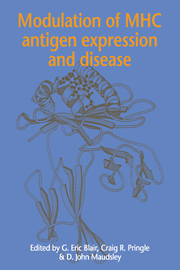Book contents
- Frontmatter
- Contents
- List of contributors
- Preface
- List of abbreviations
- 1 General introduction to the MHC
- 2 Organization of the MHC
- 3 Interactions of cytokines in the regulation of MHC class I and class II antigen expression
- 4 Control of MHC class I gene expression
- 5 Control of MHC class II gene expression
- 6 Modulation of MHC antigen expression by viruses
- 7 Modulation of MHC antigen expression by retroviruses
- 8 Modulation of MHC class I antigen expression in adenovirus infection and transformation
- 9 MHC expression in HPV-associated cervical cancer
- 10 Inhibition of the cellular response to interferon by hepatitis B virus polymerase
- 11 Cellular adhesion molecules and MHC antigens in cells infected with Epstein-Barr virus: implications for immune recognition
- 12 Effect of human cytomegalovirus infection on the expression of MHC class I antigens and adhesion molecules: potential role in immune evasion and immunopathology
- 13 Oncogenes and MHC class I expression
- 14 Mechanisms of tumour cell killing and the role of MHC antigens in experimental model systems
- 15 Manipulation of MHC antigens by gene transfection and cytokine stimulation: a possible approach for pre-selection of suitable patients for cytokine therapy
- 16 Overexpression of MHC proteins in pancreatic islets: a link between cytokines, viruses, the breach of tolerance and insulindependent diabetes mellitus?
- 17 The role of cytokines in contributing to MHC antigen expression in rheumatoid arthritis
- 18 Expression of an MHC antigen in the central nervous system: an animal model for demyelinating diseases
- Index
3 - Interactions of cytokines in the regulation of MHC class I and class II antigen expression
Published online by Cambridge University Press: 11 September 2009
- Frontmatter
- Contents
- List of contributors
- Preface
- List of abbreviations
- 1 General introduction to the MHC
- 2 Organization of the MHC
- 3 Interactions of cytokines in the regulation of MHC class I and class II antigen expression
- 4 Control of MHC class I gene expression
- 5 Control of MHC class II gene expression
- 6 Modulation of MHC antigen expression by viruses
- 7 Modulation of MHC antigen expression by retroviruses
- 8 Modulation of MHC class I antigen expression in adenovirus infection and transformation
- 9 MHC expression in HPV-associated cervical cancer
- 10 Inhibition of the cellular response to interferon by hepatitis B virus polymerase
- 11 Cellular adhesion molecules and MHC antigens in cells infected with Epstein-Barr virus: implications for immune recognition
- 12 Effect of human cytomegalovirus infection on the expression of MHC class I antigens and adhesion molecules: potential role in immune evasion and immunopathology
- 13 Oncogenes and MHC class I expression
- 14 Mechanisms of tumour cell killing and the role of MHC antigens in experimental model systems
- 15 Manipulation of MHC antigens by gene transfection and cytokine stimulation: a possible approach for pre-selection of suitable patients for cytokine therapy
- 16 Overexpression of MHC proteins in pancreatic islets: a link between cytokines, viruses, the breach of tolerance and insulindependent diabetes mellitus?
- 17 The role of cytokines in contributing to MHC antigen expression in rheumatoid arthritis
- 18 Expression of an MHC antigen in the central nervous system: an animal model for demyelinating diseases
- Index
Summary
Introduction
T lymphocytes play a central role in antigen-specific immune responses through their interactions with other cell types. These interactions are guided by specific T cell recognition of antigen associated with cell surface molecules of the MHC. The two main types of MHC molecule (class I and class II) are both involved in antigen presentation, but to different types of T cell (expressing CD8 or CD4 antigens, respectively). In addition, they normally show very different patterns of expression within tissues: most cell types of the body express MHC class I antigens, whereas the expression of MHC class II antigens is restricted primarily to cells of the immune system – macrophages, dendritic cells, B lymphocytes and (in humans) activated T lymphocytes. Teleologically, this accords with the usual functions of the T cells, which interact with antigen associated with the different types of MHC protein. Thus, class I-restricted, CD8 cytotoxic T cells may be required to interact with antigen presented by almost any cell of the body (for example, following viral infection). By contrast, a major role of class II-restricted, CD4+ helper T cells is to interact with, and help, other cells of the immune system.
Tissue distribution of MHC antigens
The distribution of MHC antigens is now known to be complex. The expression of class I antigens varies in intensity with, for example, a gradation of expression from strong to weak or negative through the following cell types: cells of the immune system, epithelial cells of the gastrointestinal and respiratory tracts, endocrine cells, striated muscle cells, hepatocytes and neurons (reviewed by Pujol-Borrell & Todd, 1987).
- Type
- Chapter
- Information
- Modulation of MHC Antigen Expression and Disease , pp. 43 - 79Publisher: Cambridge University PressPrint publication year: 1995



